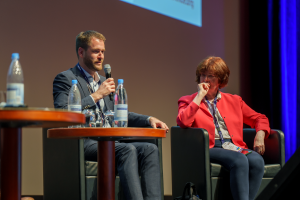By Dr Thomas Meinel
ESOC 2023 Session Report – Stroke and the Heart – Important New Findings (Joint Session with ECS)
This years #ESOC2023 Stroke and the Heart – Important New Findings session focused on various aspects on the overlap of stroke neurology and cardiology. The session was jointly organized with the European Cardiology Society and provided updates on the most burning dilemmas in this setting.
It began with Prof. Christian Nolte from Berlin, Germany, presenting on the use of rhythm monitoring to screen for atrial fibrillation after stroke or TIA. Novel wearables and apps allow for longer and more convenient screening, but need confirmation by conventional ECG. Prof. Nolte stressed that with prolonged monitoring we will find more atrial fibrillation and get into the grey zone of atrial fibrillation of short duration that might not warrant oral anticoagulation therapy.
Following, Renate Schnabel from Hamburg, Germany, spoke about the latest advancements in atrial fibrillation management specifically relevant to stroke specialists. This includes early rhythm control, which might also be an option for patients with early atrial fibrillation and recent ischemic stroke, although future trials need to confirm this. Prof. Schnable stressed that there are remaining indications for Vitamin-K antagonists, such as rheumatic heard disease associated atrial fibrillation. In the setting of concomitant stable atherosclerosis (e.g. coronary heart disease), addition of antiplatelet agents does not seems to beneficial for long-term management. However, short combination of oral anticoagulation with dual antiplatelet therapy is necessary for a short term if a percutaneous coronary intervention is necessary with the duration of dual antiplatelet therapy individualized to the patient and lesion characteristics. On the horizon, factor XI inhibitors might emerge as a novel therapeutic strategy and might overcome common problems with oral anticoagulation, e.g. suboptimal adherence.
Next, Jens Erik Nielsen-Kudsk from Aarhus N, Denmark, emphasized the importance of a multidisciplinary approach to stroke prevention in patients with AF. He also discussed novel options such as left atrial appendage occlusion, which seems to be a promising option for patients who suffer an ischemic stroke despite being on anticoagulation therapy. Further trials will assess which patients might benefit from direct oral anticoagulation, left atrial appendage occlusion or the combination of the above.
Ana Catarina Fonseca from Lisboa, Portugal, presented on the role of cardiovascular magnetic resonance imaging (CMR) in investigating stroke patients. CMR seems to be a reasonable tool for the work-up of some established structural cardioaortic sources of embolism (e.g. LV thrombus), but faces problems of feasibility and availability. CMR can even detect novel etiologies of ischemic stroke, such as subacute or chronic silent myocardial infarction and cardiomyopathies.
Lastly, Jan Kovac from Leicester, United Kingdom, discussed updates in the management of patent foramen ovale (PFO), a frequent stroke etiology in young patients. Here, the major advancement is the PASCAL classification, which allows to identify patients that will benefit from PFO-occlusion and allows to identify patients who will likely not benefit from this intervention.
Overall, this session covered a comprehensive range of topics related to cardioembolic stroke and atrial fibrillation management, highlighting the significance of rhythm monitoring, multidisciplinary approaches, and cutting-edge advancements in diagnostics and therapies for stroke prevention and treatment.




